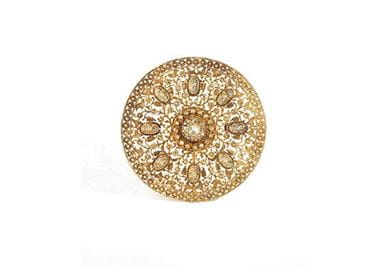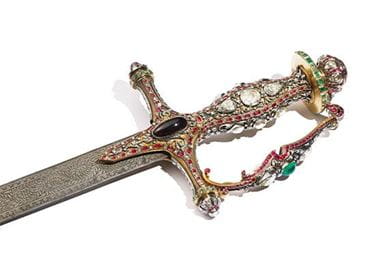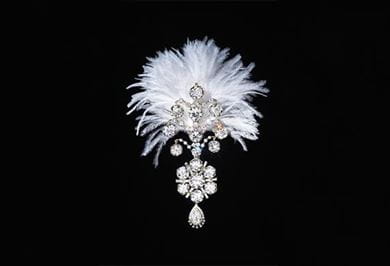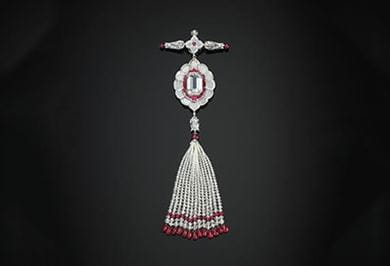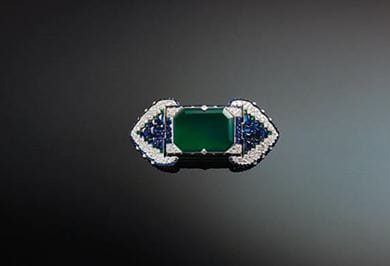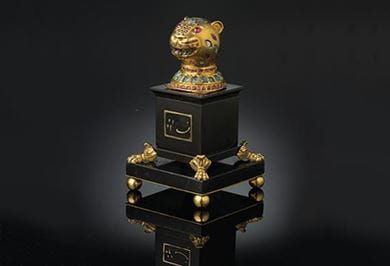






All associated with Mughal emperors, maharajas and their courts, the Al Thani Collection is a marvel in its own right
Even Sir Thomas Roe, the somewhat condescending English ambassador to the court of Jahangir, was dazzled by the Mughal emperor’s jewelled possessions. In 1616 he wrote to the future King Charles 1 in London that Jehangir’s court was ‘the treasury of the world,’ the emperor ‘buying all that comes, and heaping rich stones as if he would rather build than wear them.’
London’s Victoria and Albert Museum held a spectacular exhibition of 100 or so literally dazzling pieces of jewellery, titled Bejewelled Treasures: the Al Thani Collection. This collection was loaned by His Highness Sheikh Hamad bin Abdulla Al-Thani of Qatar, to which were added a few special pieces lent by Queen Elizabeth. As Martin Roth, then Director of the Museum, said, these included “a marvellous jewelled bird made for the throne of Tipu Sultan, the 18th century ruler of Mysore.” When Tipu was finally defeated, his throne was broken up, one captain Marriott writing in 1799 that “only the jewelled finials, the huma bird from the canopy and a large tiger head from… the throne were left.” The tiger head finial of gold set with rubies, diamonds and emeralds is another loan from the Royal Collection.
The theme of the show was to highlight examples of jewellery and jewelled objects made in India or inspired by the arts of India. In particular, the emphasis was on the Mughal heritage. This overrode, though sometimes blended with ancient Indian traditions of jewellery making, including reference to Hindu cosmology, and moved towards a new genealogy influenced by Persian literature. Examples of two definitive techniques of Mughal gold jewellery that are still used today include Kundan, which is an inherited method, dating from the 11th century and unique to the Subcontinent; and enamelling introduced in the late 16th century, and still practiced in Jaipur today. Gold ornaments were set with precious stones on the front and enamelled in translucent colours on the reverse side. It’s fascinating that with enamelling so much beauty is devoted to the back of the jewel – to invisible parts known only to its wearer and maker.
Kundan, meaning ‘finest’ or ‘purest’, refers to the highly refined gold that holds gemstones in place without the need for obtrusive settings. A commentary on a 6th century CE Sanskrit text, the Arthashastra, mentions ‘lac’, a resinous insect secretion, which is an essential component of Kundan jewelled artefacts. These are hollow and given solidity by their lac core. Enamelling was probably introduced from Europe via Portuguese Goa. On his succession to the throne in 1628 Shah Jahan commissioned the extraordinary Peacock Throne, which had Persian verses in emerald green enamel on its gold panels, and enamelled peacocks on its gold canopy.
One of the most striking and significant characteristics of this collection is the number of unmounted precious stones such as the Arcot 11 diamond presented to Queen Charlotte of England in 1767. This huge diamond, one of two ‘Diamond Drops’ weighing 33.7 and 23.65 carats had been sent by the Nawab of Arcot, who controlled the famous Golconda diamond mines, and who was a loyal ally of the British. The Golconda mines were the major source of diamonds in the world, until the Portuguese began mining in Brazil from 1725 and South African diamonds were discovered in 1867. Fantastic stories swirled around these Deccan Indian mines, including the necessity of accessing them through coils of poisonous vipers. A famous light-blue Golconda diamond in the exhibition, the ‘Idol’s Eye’, weighing in at a stunning 70.21 carats, was owned by an Ottoman sultan, and later by the disgraced former first lady of the Philippines, Imelda Marcos.
The broad chronological range of the Al Thani Collection covering the early 17th century to the present day is unique in its field. The exhibition was presented in six sections, the first of which was The Treasury evoking the royal storehouses of the Mughal emperors. Out of 12 of Akbar’s storehouses, one was reserved just for unmounted precious stones of spectacular size and superb quality. Another storehouse was for jewelled artefacts, and The Treasury displays jewellery such as necklaces of golf-ball size diamonds, many multiples of perfectly graduated strings of pearls and large spinels. In the 16th and 17th centuries, spinels (often confused with rubies) were more highly prized than any other stone for their beautiful pink colour and transparency. Akbar’s precious stone treasury was divided into three groups, the first containing in metaphysics and of the sublime in art”. The second group held diamonds, emeralds and rubies. The third was exclusively for pearls. Ornamenting the body with jewellery was and still is of immense importance in Indian culture and precious stones had specific roles in spiritual life, associated with light, beauty and virtue. Donations have always been made to temple treasuries, the omission of sapphires due to a belief that they exert a malign influence. Jewellery is a major theme in Sanskrit literature, the colours of stones evoked through metaphors such as a ruby as red lotus, or the morning sun; beryls compared to water or a parrot wing; and sapphires had ‘the lustre of a dark cloud.’ The literature was particularly lyrical in describing the magnificence of courtly life. The second section of the exhibition was The Court showcasing objects owned by rulers such as Shah Jahan, whose famous architectural commissions like The Taj Mahal introduced a new decorative style, which still informs Indian crafts to this day. Shah Jahan’s architectural influence was very specific, particularly his palette inspired by white marble inlaid with red and green hardstone. Enamellers echoed that colour scheme. It was not until the 19th century that other colours were introduced, such as cobalt blue.
The Court section included objects like Shah Jahan’s dagger (1610–20), whose white jade finial was rare. It’s in the form of the head of a young European man wearing a ruff, created at a time when European influence on the Mughal court was strong, owing to the presence of Jesuit missionaries. Another Important exhibit in The Court section was a wine cup (1607–08) made for Jahangir, the earliest dated imperial jade piece. An object of such importance would probably have been presented to the emperor during the New Year celebrations. At this time the elite of the empire exchanged presents of great opulence and rarity, poets composed special verses, and artists and craftists revealed their new work.
The third section of the show was Emerald and Kundan. Film footage of jewellers in Mumbai and Jaipur was commissioned showing how these jewellery techniques are still practiced. The design theme mirrors the physical realities of jewellery making. Celine Dalcher, the designer, used the concept of a jewellery box, with each hexagonal shape reflecting the natural crystal form of an emerald.
The Age of Transition was the 4th section, showing the gradual absorption of European styles and techniques on Indian jewellery in the late 19th and early 20th centuries, particularly in Hyderabad under the Nizams. By 1883, 30 per cent of Indian jewellery was bought by Europeans and this new market gradually changed traditional ways of working. Additionally, British firms employed Indian jewellers to create work in purely European style. Open settings allowed light to shine through cut diamonds and emeralds, and European motifs began to appear in traditional jewellery. The Curator, Susan Stronge, noted that “Cartier’s splendid pieces in the exhibition echo his collection of Mughal and Persian artefacts, particularly Safavid. There was also a profound interest in Orientalism and Pharaonic culture.” The Parisian designer Paul Iribe was influenced by both Orientalism and the Ballets Russes. His juxtaposition of emeralds next to sapphires was a stunning new colour combination, very Indian but very innovative in Europe. A blue and green brooch in the exhibition in the swooping elegant form of a peacock was given to a Spanish dancer, Anita Delegado. At the age of 16, she was whisked away by Jagatjit Singh, Raja of Kapurthala, who had instantly fallen in love with her. Eventually she became his fifth wife and on her 19th birthday, as a reward for learning Urdu, she was presented with the jewelled peacock by her husband.
The closing section, Contemporary Masters, highlighted the ongoing influence of traditional Indian jewellery though reinterpreted in transformative modern idioms. For example, the jeweller Bhagat is also influenced by Art Deco. Mumbai (where he lives) is rich in Art Deco architecture. But he also picks out elements of Mughal architecture, such as pietra dura. Bhagat has moved away from the traditional heavy gold gem-encrusted Kundan style, but does select antique flat-cut diamonds or sapphires, which emphasise the Art Deco influence. The Paris-based firm called JAR creates small sculptures, sometimes evoking Mughal architecture, such as jalis, the carved screens through which women could see but not be seen. A brooch in the exhibition recalls the stylised tiger stripes on artefacts created for Tipu Sultan.
Nita Mukesh Ambani Cultural Centre brings to the city a vibrant space for the world of music, dance, ...
I sometimes feel as though the legacy of Lord Kitchener has pursued me all of my life. I studied his ...
In 1992, Prince Charles, the Prince of Wales and heir to the British Throne visited India along with ...
Should one risk a vacation in the middle of pandemic? I thought long and hard about it before decidi ...
The Mona Lisa traces back herself to her artist Leonardo da Vinci’s life at Château du Clos Lucé in ...
The Oberoi Beach Resort, Lombok has undergone rejuvenation and evolved into a destination of unrival ...
A vivid tour through the hottest Bree Street’s central reaches that we call home to the ethical food ...
The Oberoi Beach Resort, Sahl Hasheesh, offers a royal experience amidst the colourful sea life at E ...
Located at the junction of Aravali and Vindhya ranges, Ranthambhore National Park was once a private ...
William Shakespeare lived through one of the most turbulent yet thrilling era’s of English history ...
While central Melbourne has its own allure, the city’s charm lies in its diverse suburbs, each of wh ...
Adrian Rohnfelder, a photographer with a keen interest in volcanoes and adventure, shares his extrao ...
Witness the journey of a wooden instrument that broke all the records to become the backbone of Arab ...
To leap beyond imposed restrictive limits of existence is precisely what Dimpy Menon’s artworks spea ...
More than just a circus, Phare performers use theater, music, dance and modern circus arts to tell u ...
Peru is one of the peak experiences in travel. Nowhere on earth is there such an incredibly wide ran ...
The Oberoi Sukhvilas Spa Resort, New Chandigarh helps you get in touch with yourself so that you liv ...
The establishment of the British Empire greatly influenced the architecture and culture of India an ...
Complete with red sandstone fort, torch lit ramparts and ‘Haveli’ mansions, The Oberoi Rajvilās, Jai ...
Come aboard The Oberoi Zahra, Luxury Nile Cruiser for a delightful mix of luxury and history ...
The incredible Turtle Sanctuary at The Oberoi Beach Resort, Bali, is a must-visit for nature lovers ...
As part of the Beatles, arguably the most iconic rock band of all time, John Lennon and Paul McCartn ...
Oberoi Hotels & Resorts have won the hearts of many with its exquisite charm and glorious stays ...
When I work with a subject, whether it is landscape or nudes, I’m in a relationship with whatever’s ...
Portugal’s capital city of blues from the ubiquitous blue tiling adorning buildings to fado, the sou ...
My conceptual concerts initiate dialogue using various art forms. I wanted to produce works that are ...
From sticky toffee pudding and gastro pubs, to farmers markets, heritage farm meat and stalls housin ...
German art historian Sebastian Schütze, a creative master and precise in technique, captures the hum ...
The Italian art witnessed drastic movements in the period between 1850 to 1950, giving a platform fo ...
In the age of art as speculative and subjective, beauty can seem very much beside the point. But sta ...
Complex narratives are the peak of excitement for me. Narratives like double portraits provide stimu ...
At the helm of his eponymous brand, Fendi and Chanel, the late Karl Lagerfeld became as iconic as th ...
Essentially an attempt to replicate a beautiful representation on the canvas, I hope to convey the c ...
The Oberoi, New Delhi’s makeover is an inspiration of the contemporary interpretation of Sir Edward ...
An institution rather than a hotel, the glorious Oberoi Grand, Kolkata is the place tradition calls ...
Ginarte is a journey into beauty, a harmonic synthesis, an expression of strength and delicacy, a hy ...
Oberoi Hotels & Resorts has been ranked the world’s Best Hotel Group at the Telegraph Travel Awards ...
With more than 400 displays, Toward a Concrete Utopia: Architecture in Yugoslavia, 1948–1980, is the ...
Life of the royals in medieval England, especially the queens, was full of intrigue and scandal but ...
The Asian art scene, though young, is booming and art fairs continue to play a significant role in t ...
From ebonised Georgian bracket to 19th-century French brass carriage and the 21st-century Jaeger Le- ...
The East India Company was one of the most powerful commercial endeavours the world has ever seen, d ...
With more than 400 displays, Toward a Concrete Utopia: Architecture in Yugoslavia, 1948–1980, is the ...
The Oberoi Rajvilas, Jaipur offers an exemplary experience of luxury that transports you to the gold ...
Winner of “Middle East’s Leading Luxury City Hotel” for five consecutive years by the coveted World ...
With elegantly designed villas that offer the best of interiors to its patrons, The Oberoi Beach Res ...
On the north-west coast of Africa lies Casablanca, an ancient exotic land embraced in the sweeping s ...
The new uniforms adorning the staff at The Oberoi, New Delhi are a reflection of The Oberoi Group’s ...
Swan Lake, the iconic ballet composed by Pyotr Ilyich Tchaikovsky in the late 19th century, continue ...
The Buddha, in his many iterations across South Asia, is most exquisitely represented in gilt-bronze ...
At luxury watch brand Carl F Bucherer, design is about bringing together form and function to create ...
Queen, temptress, politician, murderer: Cleopatra remains an object of fascination for writers, arti ...
Go pedal-to-metal with the best track-ready cars unveiled at the 2018 Geneva Motor Show ...
With an enchanting combination of natural splendour, medieval heritage and modern luxury, The Oberoi ...
The Oberoi Udaivilas, Udaipur, brings together the finest in nature, luxury and impeccable service t ...
The Oberoi Amarvilas, Agra, has been voted the Top India Resort Hotel at the Travel + Leisure, USA W ...
Swiss Photographer Christian Tagliavini captures 15th and 16th-century courtly culture in a series o ...
As innovations in air travel bring the UK and Australia closer, the Kangaroo Route – once stretched ...
The Oberoi, Gurgaon offers a traveller more than just the opulence of a five-star hotel: it is a san ...
In the year 1936, legendary artist Henri Matisse executed with the utmost elegance a charcoal portra ...
The elegant suites at The Oberoi, Mumbai, provide an unrivalled experience of The Oberoi Group’s sig ...
The art collection of David and Peggy Rockefeller has garnered the highest total for any private col ...
The Oberoi Philae, Luxury Nile Cruiser takes you through the highlights of the Egyptian river on a s ...
Complementing its signature old-world charm with the finest of contemporary facilities, this Oberoi ...
Truly great experiences in life, are integral to a design sensibility that seeks to create a visual ...
Modern Indian cuisine is coming into its own, with pioneering Indian chefs like Vineet Bhatia, Gagga ...
Sailing along the River Nile aboard The Oberoi Zahra, Nile Cruiser, explore Egypt’s mystical tombs a ...
Late entertainer David Bowie’s art collection, recently auctioned by Sotheby’s, is an eclectic mix o ...
Majestic lions, magnificent wild elephants and an untouched, untainted landscape weaving together na ...
From Jean Paul Gaultier and Christian Dior to Emilio Pucci and Christian Louboutin, international fa ...
world are among the most highly coveted collectible antiques today ...
Home to the perfect confluence of nature and concrete, Al Zorah gives to luxury travellers the getaw ...
An institution rather than a hotel, the glorious Oberoi Grand, Kolkata is the place tradition calls ...
Combine the exhilaration of a jungle adventure with the relaxation of a luxurious retreat at this sp ...
From exotic varieties to beautiful native species, trees can transform your estate into your own sli ...
The East and the West might speak distinct design languages, but bring them together and a spectacul ...
In the land of the midnight sun, a quintessential family vacation is punctuated by a breathtaking ex ...
The misty Wuyi mountains in Fujian, China are home to Da Hong Pao tea, which can sell for more than ...
Award-winning architect Francis Kéré talks about his design journey and giving back to his homeland ...
In Milan, designer Arthur Arbesser and his associates work and play together, perhaps setting a temp ...
Magnates of the luxury world have been taking charitable steps into the world of European applied ar ...
The culinary offerings at The Oberoi Beach Resort, Al Zorah, reflect its vibe of simple sophisticati ...
The works of 18th-century chaser-gilder Pierre Gouthiere stand testimony to the aesthetic opulence o ...
The inner health of an organisation is as important as the external forces that influence its ascent ...
The artistic traditions of mounted porcelain and enamelling lend a whimsical air to some of the most ...
The finest works of literature can sometimes make for the finest works of cinema, and the list of fi ...
The iconic Victorian writer and social critic, seen through the eyes of his great-great-great grandd ...
Be a part of the legacy of turtle conservation on the island of Bali at this luxurious beachside hav ...
With impeccable culinary offerings, Mauritian archaeological heritage and the best location on the i ...
As The Oberoi, New Delhi revels in its newly reopened avatar, take a trip down memory lane and follo ...
Passion, craftsmanship and innovation are the defining aspects of Automobili Lamborghini’s design ae ...
As the universe of food undergoes a rapid transformation across the world, The Oberoi, New Delhi’s a ...
Fashion photography is about more than garments and labels - it is about penetrating the physical fo ...
With an artistic masterpiece by Sir Winston Churchill, The Goldfish Pool at Chartwell, recently goin ...
Balancing modernity with its centuries-old heritage, Amsterdam is a study in splendour and historica ...
Dance does not exist in a box and no rules must necessarily govern it. It is a thing of beauty, myst ...
Nestled within an impregnable valley, the “lost city” of Petra is a spectacular expression of cultur ...
Oberoi Hotels & Resorts has been ranked the world’s Best Hotel Group at the Telegraph Travel Awards ...
Ayurveda, natural healing and mindfulness together create a space of rejuvenation like no other at ...
Beginning in the national capital, make your way through these travel hotspots across India that ref ...
Leonardo da Vinci’s Salvator Mundi claimed a place in auction history recently, setting a new record ...
As the beacon of Western classical music continues to shine bright, a younger generation of musician ...
One fine April morning, 16 actors and technicians set out to take Shakespeare’s Hamlet around the wo ...
From gold snuff boxes inset with diamonds, amethysts and sapphires to ornately enamelled perfume fla ...
The written word, in conjunction with innovations, lies at the very heart of history, shaping cultu ...
August 1947: It had been more than a week since freedom had arrived and the country partitioned. But ...
The Biennale des Antiquaires culminated this year in stunning glory, only to cast its spell afresh n ...
Over the years, I must have observed and recorded the behaviour of at least 125 tigers in Ranthambho ...
The ancient science of Ayurveda tells you how best to enhance your beauty and nourish not only your ...
The gleaming, fluorescent-green topsides of the superyacht Inouï may scream luxury at the Maxi Yacht ...
The world is changing and it is not changing to the benefit of the manufacturers and retailers of so ...
This season, drive in style with these uber-luxurious four-wheeled debutantes ...
The phrase, ‘home is where the heart is’ acquired a new meaning for the children at SOS Children’s V ...
India’s finest private collections of classical Indian art mindfully preserve its creative heritage ...
Make memories last forever by taking your most cherished photographs beyond the frame and photo albu ...
With breathtaking views, luxurious rooms, rejuvenating spa therapies and a state-of-the-art golf cou ...
Seamlessly weaving together traditional elements of Indian architecture, aesthetically landscaped ga ...
Exquisite collectibles going under the hammer are letting connoisseurs acquire a little bit of histo ...
Coming to India in 1865 as the principal of an art school, John Lockwood Kipling made an invaluable ...
When travelling along the path of kings and queens, The Oberoi Hotels & Resorts offer a palatial pla ...
For luxury travellers, the sky is the limit, quite literally, as a gourmet open-air meal at the base ...
From 18th-century ormolu clocks framed by candelabra to enamelled 19th-century timepieces, mantel cl ...
The Emirate of Ajman is home to The Oberoi Beach Resort, Al Zorah, a modern architectural masterpiec ...
The last queen of France was a great commissioner of beautiful things, and several of the shops she ...
From exclusive garments manufactured in Italy to style inspirations drawn from art, this is what the ...
A new facet of Pablo Picasso’s artistic repertoire is taking over the international art market his c ...
Every bottle of vintage wine has a story to tell. We give you the narratives behind five of the fine ...
In the universe of Modern art, rivalry is a complex dynamic that enables one artist to be influenced ...
A story is conditional – it is a matter of perception and might not always be, subliminally or even ...
From unique water and land activities to certified diving courses, desert tours and more, this all-s ...
Enrich your stay in Ranthambhore at this opulent jungle resort, in close proximity to nature, yet ne ...
With performative nuances and provocative appeal, Western classical music has evolved into a complex ...







Second child until maximum age of 12 years will be accommodated in the same room at additional supplement. The additional amount is not included in the room price mentioned and shall be payable at the hotel during check-out.
400 AED (including tax)
250 AED (including tax)

